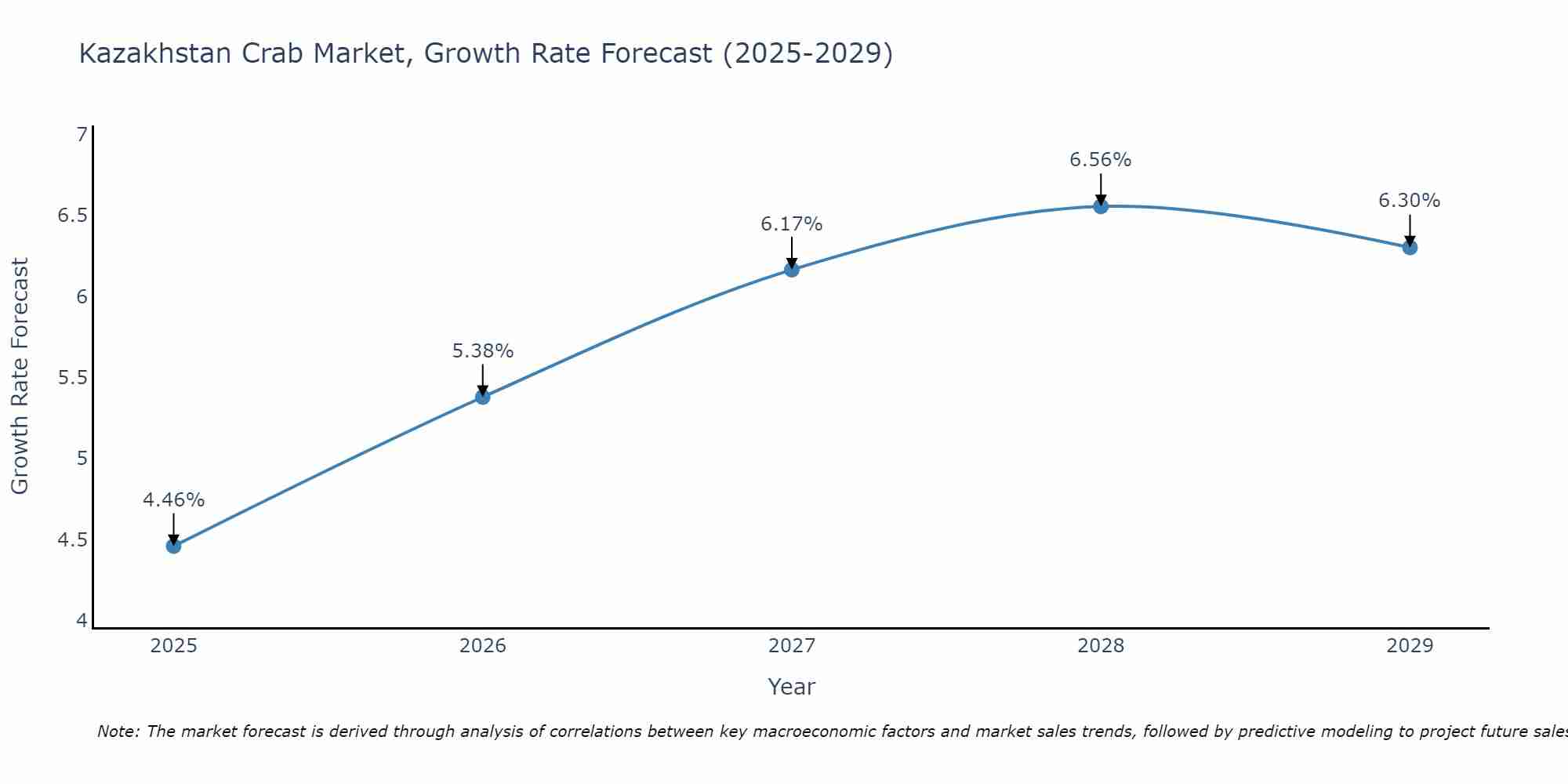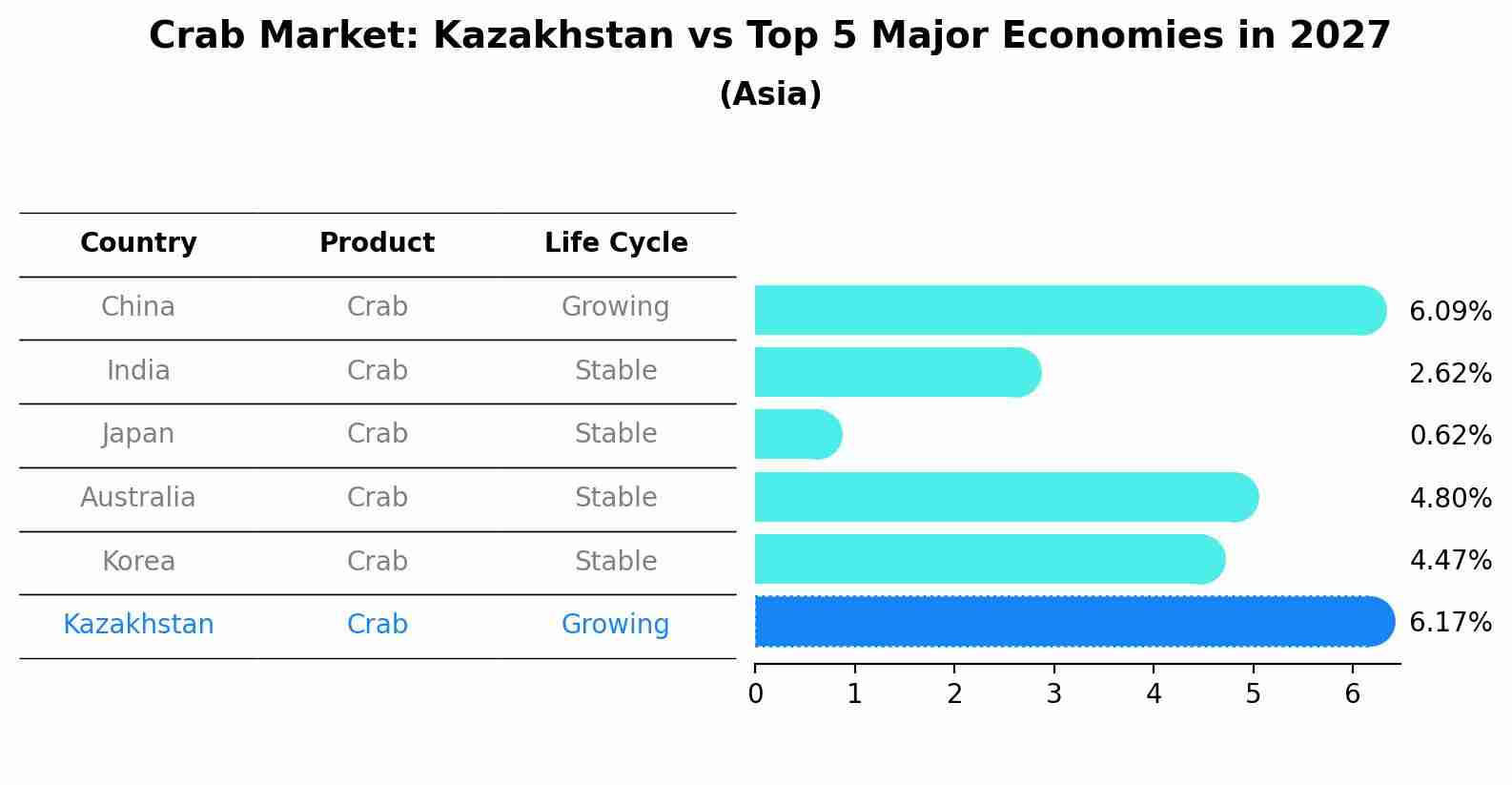Kazakhstan Crab Market Outlook | COVID-19 IMPACT, Forecast, Industry, Share, Analysis, Companies, Size, Revenue, Trends, Growth & Value
| Product Code: ETC088877 | Publication Date: Jun 2021 | Updated Date: Jun 2025 | Product Type: Report | |
| Publisher: 6Wresearch | Author: Summon Dutta | No. of Pages: 70 | No. of Figures: 35 | No. of Tables: 5 |
Kazakhstan Crab Market Size Growth Rate
The Kazakhstan Crab Market is projected to witness mixed growth rate patterns during 2025 to 2029. Starting at 4.46% in 2025, the market peaks at 6.56% in 2028, and settles at 6.30% by 2029.

Crab Market: Kazakhstan vs Top 5 Major Economies in 2027 (Asia)
By 2027, Kazakhstan's Crab market is forecasted to achieve a growing growth rate of 6.17%, with China leading the Asia region, followed by India, Japan, Australia and South Korea.

Kazakhstan Crab Market Overview
The Kazakhstan Crab Market is experiencing steady growth driven by increasing demand for seafood products in the country. The market is primarily dominated by imports, with countries like Russia and China being the major suppliers of crabs to Kazakhstan. The most popular types of crabs consumed in Kazakhstan include King Crab, Snow Crab, and Blue Crab. Consumers in Kazakhstan are increasingly willing to pay a premium for high-quality crab products, leading to the emergence of niche market segments focusing on sustainable and organic crab products. The market is also witnessing a rise in online sales of crab products, providing consumers with a convenient way to purchase fresh and frozen crabs. Overall, the Kazakhstan Crab Market presents opportunities for suppliers to cater to the growing demand for premium crab products in the country.
Kazakhstan Crab Market Trends
The Kazakhstan Crab Market is experiencing growth driven by increasing consumer demand for seafood products. The market is witnessing a shift towards sustainable and ethically sourced crab products, with consumers showing a preference for crab caught using responsible fishing methods. There is also a rising interest in premium crab varieties such as red king crab and snow crab, driven by their unique taste and texture. The market is becoming more competitive with the entry of new players offering innovative crab products and packaging to attract consumers. Additionally, there is a growing trend towards online purchasing of crab products, with e-commerce platforms providing convenience and a wider selection for consumers. Overall, the Kazakhstan Crab Market is evolving to meet the changing preferences and demands of consumers.
Kazakhstan Crab Market Challenges
In the Kazakhstan Crab Market, some challenges include limited supply due to overfishing and environmental factors affecting crab populations, such as changes in water temperature and pollution. Additionally, there are issues with illegal fishing practices and lack of proper regulations leading to unfair competition and lower quality products entering the market. Infrastructure and logistical constraints also pose challenges in the distribution of crabs to various regions within Kazakhstan and for export. Moreover, fluctuating market prices and competition from imported crabs can impact the profitability and sustainability of local crab industry players. Overall, addressing these challenges requires coordinated efforts from government authorities, industry stakeholders, and environmental organizations to ensure the long-term viability of the Kazakhstan Crab Market.
Kazakhstan Crab Market Investment Opportunities
The Kazakhstan Crab Market presents promising investment opportunities due to the increasing demand for crab products domestically and internationally. With its vast coastline along the Caspian Sea, Kazakhstan has significant potential for crab farming and wild crab harvesting. Investors can consider opportunities in establishing crab aquaculture farms to meet the growing demand for high-quality crab meat. Additionally, investments in processing facilities and distribution networks can capitalize on the export market for Kazakhstan crab products, particularly to countries in Europe and Asia. As consumer preferences shift towards sustainable and premium seafood options, investing in the Kazakhstan Crab Market can offer long-term growth potential and profitability for savvy investors looking to tap into the seafood industry`s expansion.
Kazakhstan Crab Market Government Policy
The Kazakhstan government has implemented various policies to regulate the crab market in the country. These policies include licensing requirements for crab fishing operations, restrictions on fishing quotas to prevent overexploitation of crab populations, and enforcement of conservation measures to protect the sustainability of crab resources. Additionally, the government has also established monitoring and surveillance mechanisms to prevent illegal fishing practices and ensure compliance with regulations. These policies aim to support the long-term viability of the crab market in Kazakhstan, promote sustainable fishing practices, and protect the marine ecosystem.
Kazakhstan Crab Market Future Outlook
The Kazakhstan Crab Market is expected to see steady growth in the coming years due to increasing demand for seafood products globally. Factors such as rising disposable incomes, changing dietary preferences, and a growing awareness of the health benefits of seafood are driving the demand for crabs in Kazakhstan. Additionally, the country`s strategic location with access to the Caspian Sea provides a natural advantage for crab fishing and processing. However, challenges such as environmental concerns, competition from other seafood products, and fluctuations in market prices may impact the market`s growth trajectory. Overall, with proper market positioning, quality control measures, and strategic partnerships, the Kazakhstan Crab Market has the potential for sustained growth and profitability in the future.
Key Highlights of the Report:
- Kazakhstan Crab Market Outlook
- Market Size of Kazakhstan Crab Market, 2021
- Forecast of Kazakhstan Crab Market, 2027
- Historical Data and Forecast of Kazakhstan Crab Revenues & Volume for the Period 2018 - 2027
- Kazakhstan Crab Market Trend Evolution
- Kazakhstan Crab Market Drivers and Challenges
- Kazakhstan Crab Price Trends
- Kazakhstan Crab Porter's Five Forces
- Kazakhstan Crab Industry Life Cycle
- Historical Data and Forecast of Kazakhstan Crab Market Revenues & Volume By Type for the Period 2018 - 2027
- Historical Data and Forecast of Kazakhstan Crab Market Revenues & Volume By Blue Crab for the Period 2018 - 2027
- Historical Data and Forecast of Kazakhstan Crab Market Revenues & Volume By Chinese Mitten Crab for the Period 2018 - 2027
- Historical Data and Forecast of Kazakhstan Crab Market Revenues & Volume By Gazami Crab for the Period 2018 - 2027
- Historical Data and Forecast of Kazakhstan Crab Market Revenues & Volume By Others for the Period 2018 - 2027
- Historical Data and Forecast of Kazakhstan Crab Market Revenues & Volume By Form for the Period 2018 - 2027
- Historical Data and Forecast of Kazakhstan Crab Market Revenues & Volume By Frozen for the Period 2018 - 2027
- Historical Data and Forecast of Kazakhstan Crab Market Revenues & Volume By Canned for the Period 2018 - 2027
- Historical Data and Forecast of Kazakhstan Crab Market Revenues & Volume By Others for the Period 2018 - 2027
- Kazakhstan Crab Import Export Trade Statistics
- Market Opportunity Assessment By Type
- Market Opportunity Assessment By Form
- Kazakhstan Crab Top Companies Market Share
- Kazakhstan Crab Competitive Benchmarking By Technical and Operational Parameters
- Kazakhstan Crab Company Profiles
- Kazakhstan Crab Key Strategic Recommendations
Frequently Asked Questions About the Market Study (FAQs):
1 Executive Summary |
2 Introduction |
2.1 Key Highlights of the Report |
2.2 Report Description |
2.3 Market Scope & Segmentation |
2.4 Research Methodology |
2.5 Assumptions |
3 Kazakhstan Crab Market Overview |
3.1 Kazakhstan Country Macro Economic Indicators |
3.2 Kazakhstan Crab Market Revenues & Volume, 2021 & 2027F |
3.3 Kazakhstan Crab Market - Industry Life Cycle |
3.4 Kazakhstan Crab Market - Porter's Five Forces |
3.5 Kazakhstan Crab Market Revenues & Volume Share, By Type, 2021 & 2027F |
3.6 Kazakhstan Crab Market Revenues & Volume Share, By Form, 2021 & 2027F |
4 Kazakhstan Crab Market Dynamics |
4.1 Impact Analysis |
4.2 Market Drivers |
4.3 Market Restraints |
5 Kazakhstan Crab Market Trends |
6 Kazakhstan Crab Market, By Types |
6.1 Kazakhstan Crab Market, By Type |
6.1.1 Overview and Analysis |
6.1.2 Kazakhstan Crab Market Revenues & Volume, By Type, 2018 - 2027F |
6.1.3 Kazakhstan Crab Market Revenues & Volume, By Blue Crab, 2018 - 2027F |
6.1.4 Kazakhstan Crab Market Revenues & Volume, By Chinese Mitten Crab, 2018 - 2027F |
6.1.5 Kazakhstan Crab Market Revenues & Volume, By Gazami Crab, 2018 - 2027F |
6.1.6 Kazakhstan Crab Market Revenues & Volume, By Others, 2018 - 2027F |
6.2 Kazakhstan Crab Market, By Form |
6.2.1 Overview and Analysis |
6.2.2 Kazakhstan Crab Market Revenues & Volume, By Frozen, 2018 - 2027F |
6.2.3 Kazakhstan Crab Market Revenues & Volume, By Canned, 2018 - 2027F |
6.2.4 Kazakhstan Crab Market Revenues & Volume, By Others, 2018 - 2027F |
7 Kazakhstan Crab Market Import-Export Trade Statistics |
7.1 Kazakhstan Crab Market Export to Major Countries |
7.2 Kazakhstan Crab Market Imports from Major Countries |
8 Kazakhstan Crab Market Key Performance Indicators |
9 Kazakhstan Crab Market - Opportunity Assessment |
9.1 Kazakhstan Crab Market Opportunity Assessment, By Type, 2021 & 2027F |
9.2 Kazakhstan Crab Market Opportunity Assessment, By Form, 2021 & 2027F |
10 Kazakhstan Crab Market - Competitive Landscape |
10.1 Kazakhstan Crab Market Revenue Share, By Companies, 2021 |
10.2 Kazakhstan Crab Market Competitive Benchmarking, By Operating and Technical Parameters |
11 Company Profiles |
12 Recommendations |
13 Disclaimer |
- Single User License$ 1,995
- Department License$ 2,400
- Site License$ 3,120
- Global License$ 3,795
Search
Thought Leadership and Analyst Meet
Our Clients
Related Reports
- Afghanistan Apparel Market (2026-2032) | Growth, Outlook, Industry, Segmentation, Forecast, Size, Companies, Trends, Value, Share, Analysis & Revenue
- Canada Oil and Gas Market (2026-2032) | Share, Segmentation, Value, Industry, Trends, Forecast, Analysis, Size & Revenue, Growth, Competitive Landscape, Outlook, Companies
- Germany Breakfast Food Market (2026-2032) | Industry, Share, Growth, Size, Companies, Value, Analysis, Revenue, Trends, Forecast & Outlook
- Australia Briquette Market (2025-2031) | Growth, Size, Revenue, Forecast, Analysis, Trends, Value, Share, Industry & Companies
- Vietnam System Integrator Market (2025-2031) | Size, Companies, Analysis, Industry, Value, Forecast, Growth, Trends, Revenue & Share
- ASEAN and Thailand Brain Health Supplements Market (2025-2031) | Strategy, Consumer Insights, Analysis, Investment Trends, Opportunities, Growth, Size, Share, Industry, Revenue, Segments, Value, Segmentation, Supply, Forecast, Restraints, Outlook, Competition, Drivers, Trends, Demand, Pricing Analysis, Competitive, Strategic Insights, Companies, Challenges
- ASEAN Bearings Market (2025-2031) | Strategy, Consumer Insights, Analysis, Investment Trends, Opportunities, Growth, Size, Share, Industry, Revenue, Segments, Value, Segmentation, Supply, Forecast, Restraints, Outlook, Competition, Drivers, Trends, Demand, Pricing Analysis, Competitive, Strategic Insights, Companies, Challenges
- Europe Flooring Market (2025-2031) | Outlook, Share, Industry, Trends, Forecast, Companies, Revenue, Size, Analysis, Growth & Value
- Saudi Arabia Manlift Market (2025-2031) | Outlook, Size, Growth, Trends, Companies, Industry, Revenue, Value, Share, Forecast & Analysis
- Uganda Excavator, Crane, and Wheel Loaders Market (2025-2031) | Strategy, Consumer Insights, Analysis, Investment Trends, Opportunities, Growth, Size, Share, Industry, Revenue, Segments, Value, Segmentation, Supply, Forecast, Restraints, Outlook, Competition, Drivers, Trends, Demand, Pricing Analysis, Competitive, Strategic Insights, Companies, Challenges
Industry Events and Analyst Meet
Whitepaper
- Middle East & Africa Commercial Security Market Click here to view more.
- Middle East & Africa Fire Safety Systems & Equipment Market Click here to view more.
- GCC Drone Market Click here to view more.
- Middle East Lighting Fixture Market Click here to view more.
- GCC Physical & Perimeter Security Market Click here to view more.
6WResearch In News
- Doha a strategic location for EV manufacturing hub: IPA Qatar
- Demand for luxury TVs surging in the GCC, says Samsung
- Empowering Growth: The Thriving Journey of Bangladesh’s Cable Industry
- Demand for luxury TVs surging in the GCC, says Samsung
- Video call with a traditional healer? Once unthinkable, it’s now common in South Africa
- Intelligent Buildings To Smooth GCC’s Path To Net Zero


















